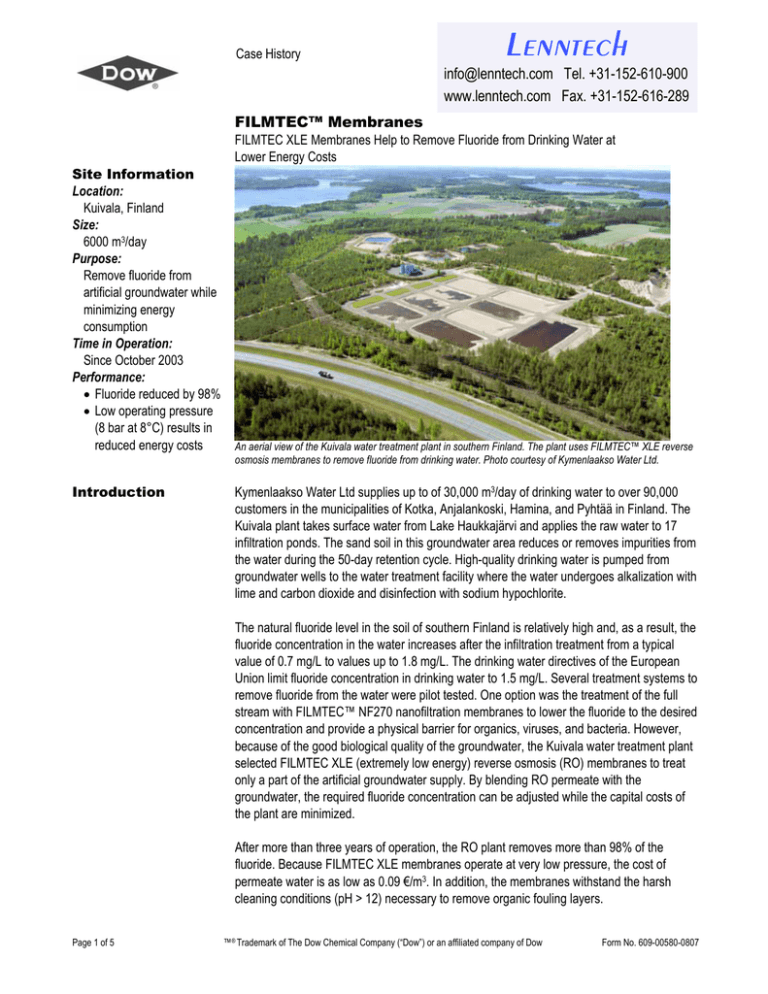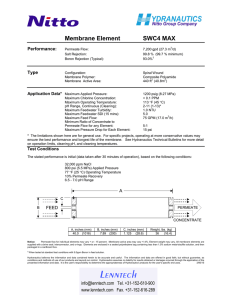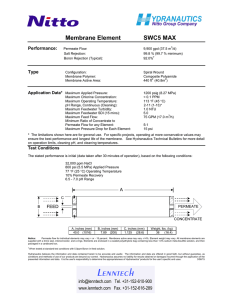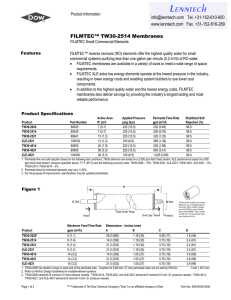Lenntech Tel. +31-152-610-900 www.lenntech.com Fax. +31-152-616-289 FILMTEC™ Membranes
advertisement

Case History Lenntech info@lenntech.com Tel. +31-152-610-900 www.lenntech.com Fax. +31-152-616-289 FILMTEC™ Membranes Site Information Location: Kuivala, Finland Size: 6000 m3/day Purpose: Remove fluoride from artificial groundwater while minimizing energy consumption Time in Operation: Since October 2003 Performance: • Fluoride reduced by 98% • Low operating pressure (8 bar at 8°C) results in reduced energy costs Introduction FILMTEC XLE Membranes Help to Remove Fluoride from Drinking Water at Lower Energy Costs An aerial view of the Kuivala water treatment plant in southern Finland. The plant uses FILMTEC™ XLE reverse osmosis membranes to remove fluoride from drinking water. Photo courtesy of Kymenlaakso Water Ltd. Kymenlaakso Water Ltd supplies up to of 30,000 m3/day of drinking water to over 90,000 customers in the municipalities of Kotka, Anjalankoski, Hamina, and Pyhtää in Finland. The Kuivala plant takes surface water from Lake Haukkajärvi and applies the raw water to 17 infiltration ponds. The sand soil in this groundwater area reduces or removes impurities from the water during the 50-day retention cycle. High-quality drinking water is pumped from groundwater wells to the water treatment facility where the water undergoes alkalization with lime and carbon dioxide and disinfection with sodium hypochlorite. The natural fluoride level in the soil of southern Finland is relatively high and, as a result, the fluoride concentration in the water increases after the infiltration treatment from a typical value of 0.7 mg/L to values up to 1.8 mg/L. The drinking water directives of the European Union limit fluoride concentration in drinking water to 1.5 mg/L. Several treatment systems to remove fluoride from the water were pilot tested. One option was the treatment of the full stream with FILMTEC™ NF270 nanofiltration membranes to lower the fluoride to the desired concentration and provide a physical barrier for organics, viruses, and bacteria. However, because of the good biological quality of the groundwater, the Kuivala water treatment plant selected FILMTEC XLE (extremely low energy) reverse osmosis (RO) membranes to treat only a part of the artificial groundwater supply. By blending RO permeate with the groundwater, the required fluoride concentration can be adjusted while the capital costs of the plant are minimized. After more than three years of operation, the RO plant removes more than 98% of the fluoride. Because FILMTEC XLE membranes operate at very low pressure, the cost of permeate water is as low as 0.09 €/m3. In addition, the membranes withstand the harsh cleaning conditions (pH > 12) necessary to remove organic fouling layers. Page 1 of 5 ™® Trademark of The Dow Chemical Company (“Dow”) or an affiliated company of Dow Form No. 609-00580-0807 FILMTEC™ XLE Elements FILMTEC™ XLE-440 elements are very low energy, high productivity, brackish water reverse osmosis elements designed to deliver high-quality water at lower operating costs for municipal and industrial water applications. • XLE-440 will operate in many systems at less than half the feed pressure of a standard high rejection RO element and at up to 30% less pressure than other low energy membranes, which can result in lifetime energy savings greater than 100% of the initial membrane investment. • With 41 m2 of active membrane area, FILMTEC XLE-440 elements give system designers the option of designing a system with fewer membrane elements, thereby reducing capital expenditures. • Automated, precision fabrication allows for very high active membrane area without compromising the thickness of the feed spacer, resulting in less fouling, less cleaning downtime, and lower operating costs than competitive products using thinner spacers. RO Plant Design The Kuivala reverse osmosis (RO) plant consists of five trains, each with six pressure vessels in the first stage and three pressure vessels in the second stage, with each pressure vessel housing six membrane elements. There is no pretreatment, just a 1 μm bag filter, and no scaling inhibitor is added. The plant operates at 80% recovery and has a capacity of 6000 m3/d with reserved capacity of an additional 3600 m3/d. The average operating pressure is 8 bar at an average temperature of 8°C, which is a flow performance similar to that provided by nanofiltration membranes. Approximately 30% of the groundwater feed is treated in the RO plant and later blended with the feed water to obtain drinking water with less than 1.3 mg/L fluoride. Brine is discharged to a river. Figure 1 shows the plant layout. Figure 1. Kuivala RO plant Photo courtesy of HyXo and Kymenlaakso Water Ltd. Page 2 of 5 ™® Trademark of The Dow Chemical Company (“Dow”) or an affiliated company of Dow Form No. 609-00580-0807 Normalized Flow Since the start-up of the RO plant in October 2003, all five trains have shown similar performance and trends. As an example, Figure 2 shows the normalized permeate flow rate of Train #4 since start-up. The initial normalized flow was higher than projected, meaning that the operating pressure was lower than expected. The first test cleaning in April 2004 (data right after cleaning are marked in red) had no effect on flow, which indicates that the observed flow decline at that time was a stabilization process rather than fouling process. The second cleaning in July 2004 improved the flow and reduced the fouling rate. Figure 2. Normalized permeate flow rate of Train #4 80 Normalized Permeate Flow (m 3/h) 70 cleaning at max. pH 12.5 60 50 projected initial performance 40 projected long-term perfomance 30 20 cleaning at max. pH 11 10 0 7 -0 ep -S 01 7 -0 un -J 01 7 -0 ar -M 02 6 -0 ec -D 01 6 -0 ug -A 31 6 -0 un -J 01 6 -0 ar -M 02 5 -0 ov -N 30 5 -0 ug -A 31 5 -0 un -J 01 5 -0 ar -M 01 4 -0 ov -N 30 4 -0 ug -A 31 4 -0 ay -M 31 4 -0 ar -M 01 3 -0 ec -D 01 3 -0 ep -S 01 Before November 2005, the alkaline cleanings were done at a moderate pH of about 11. When the cleaning efficiency decreased, the alkaline cleaning procedure was adjusted to a higher pH of about 12.2 to 12.5. This helped restore the flow performance to the level of new membranes. No cleaning was required during the second half of 2006; this could be a result of the better cleaning efficiency at high pH and/or of an improved feed water quality. Differential Pressure The pressure drop from the feed to the concentrate end of a membrane system gives information about the fouling of the feed channel spacer. Figure 3 shows the pressure drop across each of both stages of Train #4. The plot shows the direct readings of pressure differentials between feed pressure, interstage feed/concentrate pressure, and concentrate pressure. There has been a steady increase of the pressure drop from the beginning, but with the introduction of higher pH cleaning the trend could be stopped. Page 3 of 5 ™® Trademark of The Dow Chemical Company (“Dow”) or an affiliated company of Dow Form No. 609-00580-0807 Differential Pressure, cont. Figure 3. Differential pressure across both stages of Train #4 4.0 Differential Pressure of Stage 1 and Stage 2 (bar) cleaning at max. pH 12.5 Stage 1 Differential Pressure 3.5 Stage 2 Differential Pressure 3.0 2.5 2.0 1.5 1.0 0.5 0.0 04 7 -0 ep -S 01 7 -0 un -J 01 7 -0 ar -M 02 6 -0 ec -D 01 6 -0 ug -A 31 6 -0 un -J 01 6 -0 ar -M 02 5 -0 ov -N 30 5 -0 ug -A 31 5 -0 un -J 05 01 ar 4 -0 ug 04 3 3 4 -0 ay ov -N -M 01 30 -A 31 -M 31 ar -0 ec -D -0 ep -S -M 01 01 01 Salt Passage The system salt rejection after more than three years of operation is still the same as in the beginning, about 95%, despite frequent cleanings at pH >12 at temperatures >35°C. The permeate conductivity of about 6 µS/cm has not changed very much from its initial value while the feed conductivity ranges between 70 and 100 µS/cm. This shows that the membrane has not been adversely affected by the harsh cleanings. Permeate Quality Fluoride removal with RO is greater than 98%. A positive side effect is the TOC rejection of greater than 94%. Table 1 gives an overview of the permeate water quality and membrane rejection achieved with the RO plant. Table 1. Performance of Kuivala RO plant. Scaling Control Page 4 of 5 Parameters Feed (mg/L) Product (mg/L) Rejection (%) Cations Calcium Magnesium Potassium Sodium 11.9 1.62 1.29 3.8 0.11 0.01 0.23 0.34 99.1 99.4 82.2 91.1 Anions Alkalinity, as HCO3 Chloride Fluoride Nitrate Sulfate TOC pH 30 9.5 1.9 4 16 6.44 6.6 11 0.19 0.03 0.33 0.12 0.374 5.3 63.9 98.0 98.4 91.8 99.3 94.2 — The RO system operates at 80% recovery without a scaling inhibitor. The concentrate is four times oversaturated with calcium fluoride. Control elements are operated on the concentrate to detect the onset of scaling early enough to initiate cleaning. ™® Trademark of The Dow Chemical Company (“Dow”) or an affiliated company of Dow Form No. 609-00580-0807 Conclusions The Kuivala reverse osmosis plant has performed well since its start-up in 2003. The plant is automatically operated with an early warning system for scaling control. The membranes withstand the harsh cleaning conditions (pH > 12) necessary to control organic fouling. Using FILMTEC™ XLE elements, 98% of fluoride is removed (to less than 0.03 mg/L fluoride), which allows the plant to minimize the amount of water being treated to meet the European Union fluoride directives. In addition, the low operating pressure of these elements (8 bar at av. 8°C) translates to low energy costs, with the cost of permeate water calculated to be as low as 0.09 €/m3. Based on this experience and on the fact that fluoride levels in the groundwater have increased, three more trains were added to the RO system in June 2007, expanding the RO capacity to 9000 m3/day. Lenntech info@lenntech.com Tel. +31-152-610-900 www.lenntech.com Fax. +31-152-616-289 Notice: The use of this product in and of itself does not necessarily guarantee the removal of cysts and pathogens from water. Effective cyst and pathogen reduction is dependent on the complete system design and on the operation and maintenance of the system. Notice: No freedom from any patent owned by Seller or others is to be inferred. Because use conditions and applicable laws may differ from one location to another and may change with time, Customer is responsible for determining whether products and the information in this document are appropriate for Customer’s use and for ensuring that Customer’s workplace and disposal practices are in compliance with applicable laws and other governmental enactments. Seller assumes no obligation or liability for the information in this document. NO WARRANTIES ARE GIVEN; ALL IMPLIED WARRANTIES OF MERCHANTABILITY OR FITNESS FOR A PARTICULAR PURPOSE ARE EXPRESSLY EXCLUDED. Page 5 of 5 ™® Trademark of The Dow Chemical Company (“Dow”) or an affiliated company of Dow Form No. 609-00580-0807



